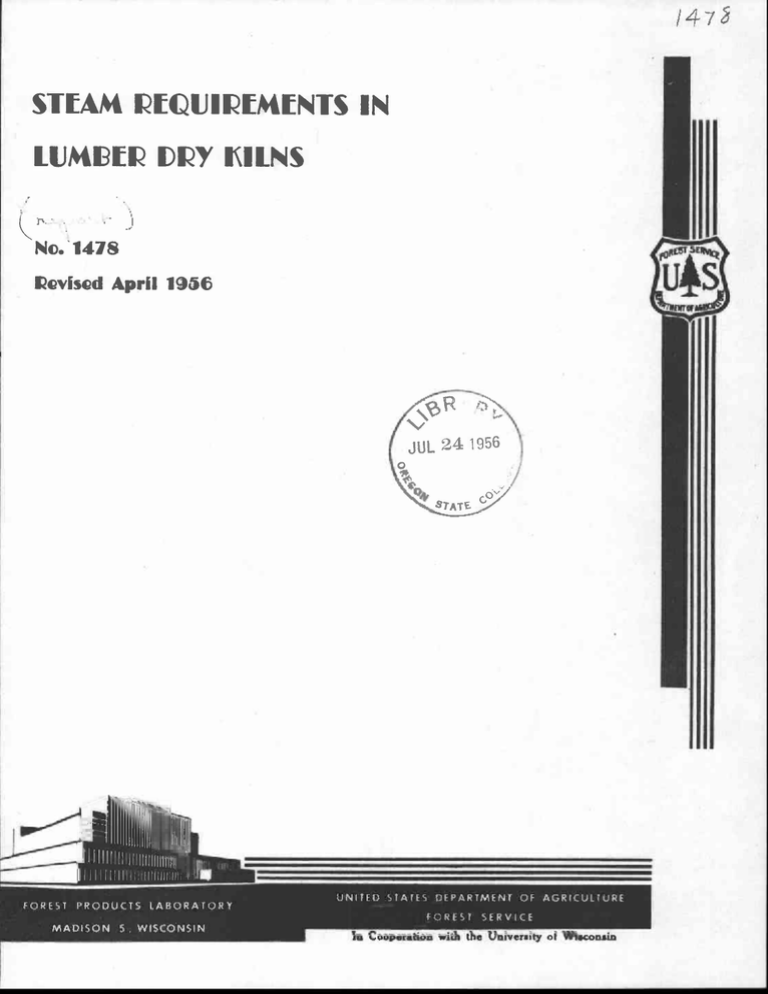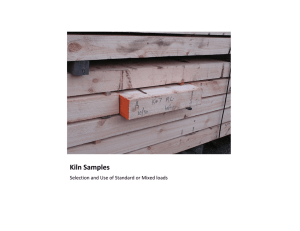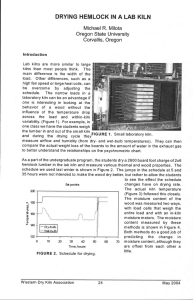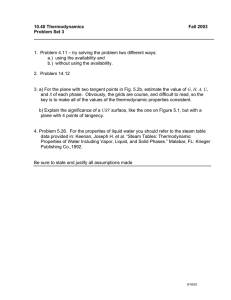/475 STEAM REQUIREMENTS IN LUMBER DRY INNS No. '1478
advertisement

/475 STEAM REQUIREMENTS IN LUMBER DRY INNS No. '1478 Revised April 1936 FOREST PRODUCTS LABORATORY MADISON 5, WISCONSIN UNITED STATES DEPARTMENT OF AGRICULTURE FOREST SERVICE la Cooperation with the University of Wisconsin STEAM REQUIREMENTS IN LUMBER DRY KILNS By Forest Products Laboratory, 1 — Forest Service U. S. Department of Agriculture The basic object in kiln drying wood is to remove part of the moisture naturally present in it, which if allowed to remain would ordinarily interfere seriously with its use. As soon as evaporation from the surface of the wood commences, a moisture gradient is established, that is, the wood has been made drier on the surface than in the interior, and thereby a movement of the moisture from the interior toward the surface has been started. As wood dries it shrinks. If the moisture gradient becomes too great, surface shrinkage will cause checks and other defects. Hence drying conditions must be so controlled that the moisture gradient will not exceed that which is safe for the species and thickness of the stock being dried. Control over drying conditions is obtained by controlling dry- and wet-bulb temperatures and maintaining a positive and ample circulation of air. In comparison with drying problems where moisture removal is the only factor the kiln drying of wood is a complex process for if the drying conditions (temperature, relative humidity, and circulation) are not properly controlled the wood may be injured and its value depreciated. Dry kilns may be divided into two general types: (a) the stationary or compartment type in which the entire charge of wood is subjected to approximately the same conditions as to dry- and wet-bulb temperatures and where such conditions are varied as the drying progresses, (b) the progressive type in which the charge is moved progressively from the entering end to the discharge end. The lowest temperatures and highest relative humidities prevail at the entering end and highest temperatures and lowest relative humidities at the discharge end. Kilns may also be either of the natural or forced circulation type. In natural circulation kilns, air movement is caused by differences in -Maintained at Madison, Wis. , in cooperation with the University of —Maintained Wisconsin. Report No. 1478 -1- Agriculture -Madison temperature and in forced circulation kilns by means of blowers, fans, steam jets, or water sprays. Most dry kilns dispose of the evaporated moisture by ventilation, that is, by passing out of the kiln some of the moist, hot air and admitting an equivalent amount of fresh air. No general comparison of efficiency of kiln types can be made since one high in evaporating efficiency may produce a product that is poorly dried and has a high degrade. Also some species may be dried rapidly under severe conditions with little degrade whereas others must be dried very slowly under mild conditions to avoid damage. The useful work accomplished in evaporating moisture from lumber may be considered as the latent heat of the evaporated moisture. The actual heat absorption is greater than this. About 30 B.t.u. per pound of dry wood are absorbed in separating the moisture from the wood when drying from a moisture content of 30 percent to zero moisture content. In practice wood is seldom dried below 6 to 8 percent moisture content and the amount of heat required to separate the hygroscopic moisture is only about 1/3 as much as when drying to zero moisture content. It is necessary, of course, to heat the wood all the way from its initial temperature to the final temperature of the kiln. The total heat expenditure required for evaporation only may be considered as the sum of (1) latent heat of vaporization, (2) heat required to overcome hygroscopic attraction of the wood, and (3) heat required to raise the temperature of the material and its contained water to the temperature of evaporation. To this must be added the amount of heat lost by radiation through walls, ceiling, and floor; heat required to raise the temperature of the air in the kiln; heat required for the air entering in ventilated kilns or for reheating the air in condensing kilns; and the, amount of steam used in steam sprays for humidifying and for steaming or conditioning treatments. The amount of steam required to evaporate a known amount of moisture at given conditions can readily be calculated and heat losses can also be calculated within reasonable limits. For estimating purposes in ventilated kilns an allowance for heating of about 5 percent of the gross volume of the kiln space should be made for the fresh air that is admitted per minute to replace the exhausted moist air. The steam used for humidification varies enormously and depends to a considerable degree upon the construction of the kilns and the skill of the operator. In well-insulated kilns having tight doors and vapor resisting construction, vapor losses are low and a skillful operator can save steam by careful operation of the exhaust dampers. Preferably, an automatic device should be used for operating the dampers. In either case, the object is to use the evaporated moisture from the wood so far as possible in order to reduce the quantity of steam required for the Report No. 1478 -2- control of relative humidity. Steam used in steam sprays may vary from 25 to 100 percent of that used in the heating coils. The condensation per square foot of radiation in dry kilns, assuming proper size of supply lines, drain lines and traps, depends upon (1) air circulation across the coils, (2) steam pressure, and (3) kiln temperature. In natural circulation kilns about 1 square foot of radiation is allowed for each 6 cubic feet of kiln space above the rail level. At 5 pounds steam pressure the maximum kiln temperature is between 165° and 180° F. and this temperature occurs when the lumber is practically dry. For higher temperatures high pressure steam is used. In one kiln the maximum condensation per square foot at a temperature of 185° F. and 15 pounds steam pressure was 0. 17 pound per square foot per hour. Only about one-third of this amount was used to maintain a temperature of 120° F. At 75 pounds steam pressure and 180° F. the maximum condensation was 0. 39 pound per square foot. In kilns having forced circulation the amount of radiation required is reduced because the efficiency of the heating surface is increased. Table 1 shows the amount of steam required per 1,000 board feet to dry various hardwoods from an air-dried condition averaging 20 percent moisture content to a final average moisture content of 5 percent, and for various softwoods from the green condition to a moisture content of 5 percent. The table is based on well-constructed compartment kilns utilizing steam to control the humidity and thermostatic devices to regulate the temperature and relative humidity. Where no means of controlling humidity is used, somewhat less steam is required and the quality of the product is lower. In poorly insulated kilns and kilns with leaky doors and walls, the steam consumption increases. Report No. 1478 -3- 1. -5 Table 1. --Estimated steam consumption for 1-inch lumber in commercial kilns Species :Condition :Time of : Pounds of :Pounds steam : Pounds : drying : water : per pound of : of steam : per M water :evaporated: . : Days : per M : evaporated : Birch and maple :Air-dried: 6 to 8 . 575 : 2.5 to 4 Douglas -fir Clears —1 1 Common— : Green • 3 Green : 2-3/4 : 800 : 515 : Longleaf pine : Green : Oak :Air-dried: 8 to 12 : : 2.58 2.44 600 2,064 1,254 : : 4,000 to 5,500 : 3 to 4.5 . : 1,800 to : 2,700 2 to 2.75 2,000 4 : 1,450 to 2,350 Ponderosa pine : Green 4 1,800 : 2 to 2.75 : 3,600 to 5,000 Shortleaf pine : Green 4 2,550 ; 2 to 2.75 : 5,100 Sweetgum :Air-dried: 7 to 10 : Western hemlock : : Clears— 1 Common— : Green Green 450 1,943 : 1,710 ; 2.5 to 4 to 7,000 to 1,800 : 1,100 2.59 : 5,025 2.55 : 4,353 1 —Davis, Virgil C. Steam Consumption in the Kiln Drying of Western Softwoods. Jour. of For. Prod. Res. Soc. Vol. IV, No. 5, October 1954. Report No. 1478





